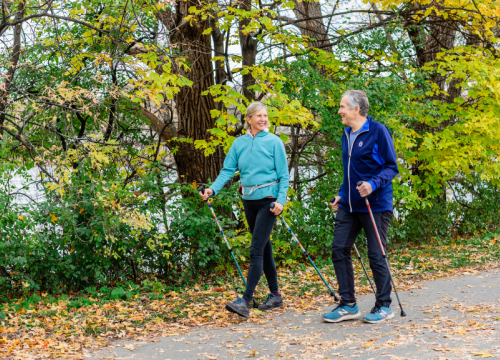Fall Prevention in Parkinson’s
Around 60% of people with Parkinson’s disease (PD) fall every year. Some falls result in minor scrapes or bruises, but others can have a lasting impact on mobility and independence. Learning how PD affects balance and taking steps to lower your fall risk can maximize your safety and independence.
Reasons for Falls in Parkinson's
Parkinson's changes the way people move, often causing challenges with balance, walking and posture that may lead to falls. Since PD affects each person differently, recognizing your unique challenges can help you identify ways to stay safe. Common reasons for falls in PD include:
- Walking changes
Shorter, slower or shuffling steps can affect balance or lead to tripping. - Balance issues
Parkinson's disrupts some of the natural movements and reflexes that maintain upright posture and balance. - "Freezing"
Described as feeling like the feet are stuck to the floor, freezing can be triggered by doorways, turns, stress or meds wearing off. Not everyone experiences this, but those who do are at a higher risk of falling. - Low blood pressure
Parkinson's affects the autonomic system, which can cause drops in blood pressure, particularly when standing up. Symptoms of low blood pressure, such as fatigue, dizziness or lightheadedness, can impact balance. - Medication side effects
Medications, including those prescribed for PD, can cause side effects like sleepiness and confusion, which can result in falls. - Muscle weakness
PD symptoms can make it harder to keep moving, which can weaken leg and core muscles and impact balance. Fear of falling can add to this issue. - Thinking changes
Parkinson's can affect focus, making multitasking — already challenging — even trickier. Walking while distracted may lead to falls. - Vision and perception issues
Parkinson's can cause blurry or double vision and difficulty judging distances. These changes can affect spatial awareness and balance. Though not directly linked to PD, hearing loss can also affect balance.
Are you at risk of falling?
- Have you fallen before?
- Do you tend to trip?
- Do you feel unsteady when walking?
- Do you experience freezing episodes?
- Do you ever feel dizzy, weak or fatigued?
- Do you take medications that may affect balance?
- If you depend on a mobility aid, like a walker, do you ever neglect to use it?
- Do you make nighttime bathroom visits?
If you answered yes to any of the questions above, talk to your doctor. You may be at risk of falling.
Strategies for Improving Balance and Reducing Falls
Start with your doctor to identify possible fall risks.
- Review medications. Your doctor can adjust medications to reduce fall risks or better manage PD symptoms.
- Check blood pressure. Medications and PD can lower blood pressure and may cause falls. Watch for orthostatic hypotension — a drop in blood pressure that happens when standing up. Talk to your doctor about strategies and medications.
- Screen for hearing and vision changes and other conditions that could affect movement or balance. Your doctor may refer you to specialists for further evaluation.
Stay active.
Regular exercise helps manage PD and may reduce falls. Before starting, ask your doctor for a referral to physical or occupational therapy for an evaluation and individualized exercises.
Physical and occupational therapists help you stay active with:
- Personalized exercises for balance and mobility.
- Strategies for PD challenges like freezing and short steps.
- Mobility aid suggestions like walking poles, canes or walkers.
- Home safety evaluations and modifications.
- Tips for maintaining daily activities.
Some therapists have extra training in PD through programs like LSVT BIG and PWR!Moves. Visit lsvtglobal.com or pwr4life.org.
Make your home safe.
Remove tripping hazards like clutter, loose rugs and cords, install grab bars in the bathroom and add nightlights. Review our home safety checklist at Parkinson.org/HomeSafety.
If a fall occurs:
- Stay calm.
- Scan for injuries and call for help if needed.
- Take your time and plan your moves before getting up.
- If able, crawl or scoot to a heavy piece of furniture for help getting up.
Tips for Safer Movement
- Take your time with movements like sitting, standing or turning corners.
- Widen your stance and take bigger steps for more stability.
- Keep frequently used items within easy reach.
- Keep hands free and limit distractions and multitasking while walking.
- Consider using fall detection technology like a medical alert system.


